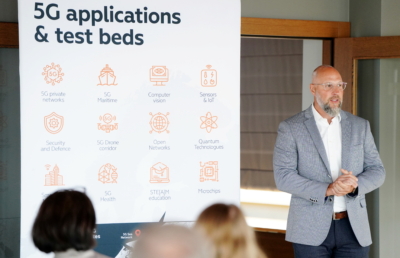Poised to make its entrance in 2030, the forthcoming 6G mobile era promises to redefine our digital landscape once again. However, the prospect of realizing future connectivity’s potential hinges on the proactive collaboration of industries, policymakers, and other key stakeholders.
Dr. Raffaele de Peppe – a Board Member and Vice Chair of the 6G Industry Association (6GIA) – addressed the pressing question of why, in the early stages of 6G’s development, dialogue with verticals is already underway – and proving to be productive.
He recounted the journey that began in 2018, when the 5G Industry Association – 6GIA’s precursor – recognized the need to involve verticals during the earlier stages of 5G’s evolution. This led to the creation of a dedicated task force chaired by Raffaele.
Their mission is to work with the key verticals to ensure that the new “G” is more than just a technical leap and becomes a genuine driver of the digital transformation of our economies.
Raffaele talked with Julia Gifford, Head of Communications at 5G Techritory, as part of the podcast series organized by the Smart Networks And Services International And European Cooperation Ecosystem (SNS ICE). The complete podcast is available for listening on Spotify here:
Or you can listen to the episode on other platforms:
Involving verticals from day one
Julia: Why, at this extremely early stage in the development of 6G, are we talking to verticals, and why is it important?
Raffaele: We have been engaging with verticals since 2018 to involve them in 5G. At that time, the 5G Industry Association – the predecessor to 6GIA – decided to create a special task force at the board level to engage with verticals. Since then, I’ve been chairing this task force, aiming to include key vertical sectors of the European economy in the development of 5G and the definition of 6G from a very early stage.
We are designing a new mobile generation for the upcoming decade that will bring benefits for both the mass consumer market and industrial customers. 6G, like 5G, will be more and more industry-oriented to support the digital transformation process of our economies. 6G will be AI-native – it is designed to serve industries with smart connectivity and, hopefully, digital services.
Now, as it was then, it’s important to engage verticals from Day 1 – to accommodate their needs in the design of technology they will adopt in the near future.
Julia: Do you think that these early-stage discussions with vertical representatives can minimize the disappointment with the new G, as we’ve seen happen with 5G?
Raffaele: Yes, engaging with verticals in early-stage discussions will allow them to contribute to 6G design, so it can be more tailored to their specific needs. On the technology side, we have a solid process to keep verticals involved from research to adoption – verticals participate in financed projects with vendors and operators, define use cases for pilots and PoCs, and finally, take part in large-scale trials to validate 6G against the use cases they have defined.
Of course, the adoption of 6G will not depend solely on technology itself. Regulatory roadblocks, the economic sustainability of 6G, and the emergence of innovative services are other factors that must come together to ensure the success of 6G across various verticals. If vendors, operators, and policymakers collaborate with verticals, then we have a chance to minimize the disappointment associated with a new “G”. Establishing the right ecosystem from Day 1 will be crucial in this regard.
Collaborating with verticals: from MoUs to technical trials
Julia: What is the best way to interact with verticals, and what kind of input do you, as 6GIA, need from them, for the most successful results to be achieved in eventual 6G deployment?
Raffaele: We have successfully implemented a “vertical engagement” strategy. The first pillar of this strategy is partnerships with verticals based on Memorandums of Understanding (MoUs). We have signed MoUs with the most prominent vertical forums in Europe: 5GAA for Automotive, 5G ACIA for Smart Manufacturing, ESA for Space, PSCE for Public Safety, ECSO for Cybersecurity, ERTICO for Transportation, and the 6G Health Institute for Health. And we are on the verge of signing with 5GMAG (EBU) for Media.
The MoU agreements we have established with all these vertical forums serve as a collaboration framework, fostering other engagement activities. For example, we commit to attending key vertical events with high-level, primarily board-level speakers to promote 5G (now 6G), generate awareness, and build momentum. Moreover, we invite our MoU partners to join our working groups, where we collaboratively generate whitepapers on topics of mutual interest.
This allows us to gather their input and transform it into technical requirements, which are then tested through trials and pilots – thus ultimately shaping industry standards. We have formed a dedicated group with all these verticals to discuss the standardization strategy, primarily for 3GPP. The next step would be to engage with policymakers and regulators to promote pro-investment policies for 6G.
Getting a head start on 6G
Julia: There is still much to be done with 5G – do you think that we’re getting ahead of ourselves, discussing 6G already at this stage?
Raffaele: 5G has been up and running for a while, but the industrial version of 5G – 5G Stand Alone – has just arrived. So, let’s see what happens with this advanced version, particularly tailored for industries. A new “G” needs a 10-year cycle from research to adoption. Therefore, it is not too early to discuss 6G.
4G was conceived in the early 2000s and entered the market in 2010. After 2010, 5G research started and reached the mass market in 2020, with some early launches in 2019. 6G research began in 2020 and is expected to hit the market in 2030, with some parts of the world launching ahead of schedule.
Innovation cycles in technology tend to shorten, and this holds true for mobile technologies as well. However, we must carefully align with market conditions and the overall industry situation. Today, operators are still struggling to monetize 5G, so they may not be eager to hear about 6G for a while – unless it’s in the corridors of their labs.
Why 6G demands a more holistic and pragmatic approach
Julia: If there was one unifying lesson about what verticals need, what would that be, and how would you characterize it?
Raffaele: I have been working with verticals for years now, and I know they have a very pragmatic approach. They don’t want mobile technologies – they want solutions for their needs. “Gs” is just marketing for our industry, but for verticals, “Gs” don’t really matter. They need solutions regardless of whether they are based on 4G, 5G, or 6G, as long as the solution is available in a timely and economically viable manner.
In this respect, we must strengthen our research on new services that can be delivered within 6G networks, transforming them into a one-stop shop of digital services and technologies. Thus, for 6G, we require a more holistic approach.
Bottom-up research is no longer sufficient – we also need top-down guidance based on a robust vision, encompassing not only our sectors but also all the sectors we aim to serve with 6G. This vision, in addition to our ongoing efforts within the VTF, will be furnished through the SNS ICE project – a stewardship initiative that delves deeper into vertical engagement for 6G.



